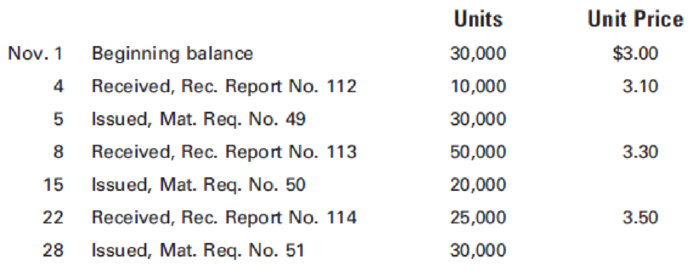
Principles of Cost Accounting
17th Edition
ISBN: 9781305087408
Author: Edward J. Vanderbeck, Maria R. Mitchell
Publisher: Cengage Learning
expand_more
expand_more
format_list_bulleted
Concept explainers
Textbook Question
Chapter 2, Problem 5P
Inventory costing methods
The purchases and issues of rubber gaskets (Materials Ledger #11216) as shown in the records of Hillsdale Corp. for November follow:

Required:
- 1. Complete a materials ledger account similar to Figure 2-10 (the “On Order” columns should be omitted) for each of the following inventory costing methods, using a perpetual inventory system:
- a. FIFO
- b. LIFO
- c. Weighted average (carrying unit prices to five decimal places)
- 2. For each method, prepare a schedule that shows the total cost of materials transferred to Work in Process and the cost of the ending inventory.
- 3. If prices continue to increase, would you favor adopting the FIFO or the LIFO method? Explain.
- 4. When prices continue to rise, what is the effect of FIFO versus LIFO on the inventory balance for materials reported in the
balance sheet ? Discuss.
Expert Solution & Answer
Trending nowThis is a popular solution!

Students have asked these similar questions
Given answer financial accounting question
What is the true answer? ?
None
Chapter 2 Solutions
Principles of Cost Accounting
Ch. 2 - What are the two major objectives of materials...Ch. 2 - Prob. 2QCh. 2 - What factors should management consider when...Ch. 2 - Prob. 4QCh. 2 - What kind of information and data are needed to...Ch. 2 - How would you define the term economic order...Ch. 2 - What kind of information and data are needed to...Ch. 2 - What factors should be considered when determining...Ch. 2 - Prob. 9QCh. 2 - Prob. 10Q
Ch. 2 - Prob. 11QCh. 2 - Proper authorization is required before orders for...Ch. 2 - Prob. 13QCh. 2 - Prob. 14QCh. 2 - Prob. 15QCh. 2 - Prob. 16QCh. 2 - Prob. 17QCh. 2 - Normally, a manufacturer maintains an accounting...Ch. 2 - Prob. 19QCh. 2 - Why do companies adopt the LIFO method of...Ch. 2 - Prob. 21QCh. 2 - Prob. 22QCh. 2 - Prob. 23QCh. 2 - Prob. 24QCh. 2 - Prob. 25QCh. 2 - Prob. 26QCh. 2 - Prob. 27QCh. 2 - Prob. 28QCh. 2 - A manufacturing process may produce a considerable...Ch. 2 - After a product is inspected, some units may be...Ch. 2 - Order Point Pershing, Inc. expects daily usage of...Ch. 2 - Economic order quantity; order cost; carrying cost...Ch. 2 - Economic order quantity; order cost; carrying cost...Ch. 2 - Journalizing materials requisitions Penrose...Ch. 2 - Recording materials transactions Prepare a journal...Ch. 2 - PurrChems raw materials records contained the...Ch. 2 - Using first-in, first-out perpetual inventory...Ch. 2 - LIFO costing Using last-in, first-out perpetual...Ch. 2 - Using the weighted average method of perpetual...Ch. 2 - Prob. 10ECh. 2 - Renfro, Inc. was franchised on January 1, 2016. At...Ch. 2 - Recording materials transactions Craig Products...Ch. 2 - Recording materials transactions Broadwell...Ch. 2 - JIT and cost control Matsui Industries produces...Ch. 2 - Kenkel, Ltd. uses backflush costing to account for...Ch. 2 - For E2-15, prepare any journal entries that would...Ch. 2 - Davis Co. uses backflush costing to account for...Ch. 2 - For E2-17, prepare any journal entries that would...Ch. 2 - A machine shop manufactures a stainless steel part...Ch. 2 - Spoiled work Roger Company manufactures tennis...Ch. 2 - Defective work Herbert Electronics manufactures an...Ch. 2 - Perry Co. predicts it will use 25,000 units of...Ch. 2 - Prob. 2PCh. 2 - Economic order quantity; tabular computation Lopez...Ch. 2 - In P2-3, assume that the company desires a safety...Ch. 2 - Inventory costing methods The purchases and issues...Ch. 2 - Inventory costing methods The following...Ch. 2 - Terrills Transmissions uses a job order cost...Ch. 2 - Prob. 8PCh. 2 - Tuscany Products, Inc. uses a job order cost...Ch. 2 - Prob. 10PCh. 2 - JIT and cost control Langray, Ltd. produces 50,000...Ch. 2 - Backflush costing Russell Corp. uses backflush...Ch. 2 - Webster Company uses backflush costing to account...Ch. 2 - An examination of Buckhorn Fabricators records...Ch. 2 - One of the tennis rackets that Ace Sporting Goods...Ch. 2 - Lloyd Industries manufactures electrical equipment...Ch. 2 - Review Problem for Chapters 1 and 2 UltraLift...Ch. 2 - Financial and Nonfinancial Aspects of Changing to...Ch. 2 - Prob. 2MC
Knowledge Booster
Learn more about
Need a deep-dive on the concept behind this application? Look no further. Learn more about this topic, accounting and related others by exploring similar questions and additional content below.Similar questions
arrow_back_ios
SEE MORE QUESTIONS
arrow_forward_ios
Recommended textbooks for you
 Principles of Cost AccountingAccountingISBN:9781305087408Author:Edward J. Vanderbeck, Maria R. MitchellPublisher:Cengage Learning
Principles of Cost AccountingAccountingISBN:9781305087408Author:Edward J. Vanderbeck, Maria R. MitchellPublisher:Cengage Learning Cornerstones of Financial AccountingAccountingISBN:9781337690881Author:Jay Rich, Jeff JonesPublisher:Cengage LearningPrinciples of Accounting Volume 1AccountingISBN:9781947172685Author:OpenStaxPublisher:OpenStax College
Cornerstones of Financial AccountingAccountingISBN:9781337690881Author:Jay Rich, Jeff JonesPublisher:Cengage LearningPrinciples of Accounting Volume 1AccountingISBN:9781947172685Author:OpenStaxPublisher:OpenStax College Financial AccountingAccountingISBN:9781337272124Author:Carl Warren, James M. Reeve, Jonathan DuchacPublisher:Cengage Learning
Financial AccountingAccountingISBN:9781337272124Author:Carl Warren, James M. Reeve, Jonathan DuchacPublisher:Cengage Learning Intermediate Accounting: Reporting And AnalysisAccountingISBN:9781337788281Author:James M. Wahlen, Jefferson P. Jones, Donald PagachPublisher:Cengage LearningCentury 21 Accounting Multicolumn JournalAccountingISBN:9781337679503Author:GilbertsonPublisher:Cengage
Intermediate Accounting: Reporting And AnalysisAccountingISBN:9781337788281Author:James M. Wahlen, Jefferson P. Jones, Donald PagachPublisher:Cengage LearningCentury 21 Accounting Multicolumn JournalAccountingISBN:9781337679503Author:GilbertsonPublisher:Cengage

Principles of Cost Accounting
Accounting
ISBN:9781305087408
Author:Edward J. Vanderbeck, Maria R. Mitchell
Publisher:Cengage Learning

Cornerstones of Financial Accounting
Accounting
ISBN:9781337690881
Author:Jay Rich, Jeff Jones
Publisher:Cengage Learning

Principles of Accounting Volume 1
Accounting
ISBN:9781947172685
Author:OpenStax
Publisher:OpenStax College

Financial Accounting
Accounting
ISBN:9781337272124
Author:Carl Warren, James M. Reeve, Jonathan Duchac
Publisher:Cengage Learning

Intermediate Accounting: Reporting And Analysis
Accounting
ISBN:9781337788281
Author:James M. Wahlen, Jefferson P. Jones, Donald Pagach
Publisher:Cengage Learning

Century 21 Accounting Multicolumn Journal
Accounting
ISBN:9781337679503
Author:Gilbertson
Publisher:Cengage
Chapter 6 Merchandise Inventory; Author: Vicki Stewart;https://www.youtube.com/watch?v=DnrcQLD2yKU;License: Standard YouTube License, CC-BY
Accounting for Merchandising Operations Recording Purchases of Merchandise; Author: Socrat Ghadban;https://www.youtube.com/watch?v=iQp5UoYpG20;License: Standard Youtube License